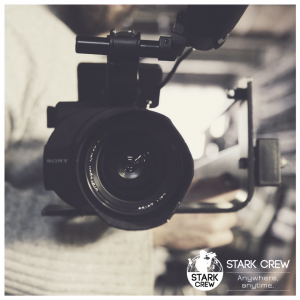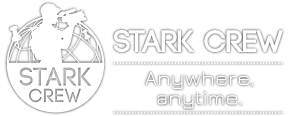
We are launching a series of behind the scenes information articles and this first series is based on “How to make great event videos.”
Whether you are shooting a convention, seminar, workshop, or launch party, event videos are some of the most challenging – exciting – videos you can make. Of course, a great video is built upon great foundations.
INSIDER TIP #1: Get the right crew size.
For budgetary reasons, we sometimes get asked to just send one person to film everything. Sure, you can send a person with a camera and ask them to shoot & record sound themselves, but your video will look like a bad news segment.
Here´s the problem: if only one person is expected to be responsible for both the image and audio, as well as for interviewing people, they just have too much on their plate. They are not going to notice that the microphone is crackling or that your interviewee has mustard on her shirt.
Everyone has a specific job to do. By understanding each job, you can start to understand the importance of selecting the right crew configuration for your event.
PRODUCER: It´s the producer´s job to set up all of the logistics of the shoot – which are often a bit crazy when it comes to events because things on the ground can change in a second. The producer works with the venue to set up everything from parking and event access for the crew, to shooting locations, interview schedules, gear lists, and solving problems as they arise (which they always do). When someone at the event says , “sorry, we can no longer shoot in this location for such and such reason, and everything has to be moved to another location…” – it is the producer´s job to fix that problem ASAP.
DIRECTOR: the director´s job on an event video is to direct the creative look and feel of the video. They tell the rest of the crew how and where to shoot. In addition to executing a cinematic video for your event video, in the context of most events, they are also responsible for interviewing your interviewees. In the role of interviewer, the director will direct” non-actors who are often executives, customers, experts, or other VIPs. These people are often nervous on camera and need coaching to smile and look their best in the video. The director is an expert at putting them at ease.
DOP (DIRECTOR OF PHOTOGRAPHY): Many folks interchange the word DOP with camera person, but at Stark Crew we think of a DOP as a videographer with a very cinematic eye and shooting style. We think of camera people being more for news, and DOPs being more for documentary and film work. Even if we take additional videographers to the event, the DOP will direct them as the lead videographer in order to make sure that the cinematic shooting style is consistent.
SOUND TECHNICIAN: Should a videographer also be the person recording sound on your video? In a word: NO. Let´s make that three words: NO FRICKIN´ WAY. Get a sound technician. Unless you don´t care about audio problems such as car noise, sirens, heavy breathing, crackling sounds, static, and about a million other things that can go wrong with audio, then you need a person dedicated 100% to making sure that the audio is clean and clear. We aim for all of our interviews to have that “radio voice” sound, and that can only happen with a professional sound technician who comes to the shoot with various types of microphones for all kinds of situations, an audio mixer, and many years of experience.
MAKEUP TECHNICIAN: An often overlooked crew member, we greatly encourage that all event video productions have a makeup professional on the crew. Just think about it: your interviewees are spending the event day running around doing all kinds of things, and they are getting sweaty and looking a bit undone as they go about it. When you finally get them into the interview chair, they may look a bit overwhelmed and overworked. For both men and women, the makeup technician will get them looking fresh and bright. Whether it´s just a minimal dash of powder or a bit more sprucing up, when you see the final video, all of the stakeholders involved such as yourself, your colleagues, the audience, and the interviewees themselves are going to greatly appreciate the quick fix that a professional makeup technician will do. After all, it is a cringing experience for everyone to see an interviewee that is flushed and sweating with a crooked tie or a bunched collar. Another benefit we have learned about over the years is that people LOVE sitting down with makeup techs. It´s an experience: the mirror, the chair, the lights, the chatting it up with the makeup tech. We have seen top executives, experts, authorities, and other VIPs go into a complete state of well-needed relaxation by just sitting down in the makeup tech´s chair. We´ve also noticed that they come out of it recharged and ready to do an engaging video interview.
LIGHTING TECH: In film and TV, the Lighting Tech is called a GAFFER and is the lighting planner who then delegates the plan to be implemented by a crew member called the KEY GRIP. However, in small crews we wrap all of these roles into one role called the Lighting Tech. This is the person responsible for managing lighting plans, lighting gear, and electrical solutions as directed by the DOP. Video is essentially “painting with light” and you cannot underestimate the value of having a professional lighting technician to get that cinematic look, especially in difficult, multiple locations within event venues. Keep in mind that in event venues, access to electrical outlets can be tricky, as well as working with mixed light sources from the venue´s own electrical lighting structures and windows. You´ll need a pro to deal with all of that.
ADDITIONAL CAMERA PERSON: We often recommend an additional camera person on event videos – there is just too much space to to cover, and often there are simultaneous activities that need to be filmed. If the event is huge, you might need many more camera people. However, in our experience, we usually get by with a DOP and one extra camera person.
PRODUCTION ASSISTANTS: As you can see above, the crew consists of highly trained and experienced video experts. They need to focus on their areas of expertise, and it makes their jobs a lot easier and more focused, if they have access to production assistants. These assistants do everything from getting water and coffee to carrying equipment and running errands. Essentially, they do grunt work. That said, PAs are thrilled to be on the set as this is often the first position they hold in the industry, and it is the best way to learn about working on a production. Almost everyone who has worked in video and film started as a PA!
In summary, when it comes to your video crew: the more, the better. While many film professionals are well-rounded and can do a bit of everything, all are specialists in one specific area. The more attention they can focus on their one specific area of expertise, the better your video will look.
Remember, when it comes to your film crew, multi-tasking is the enemy. But at the end of the day, it depends on your project brief. If you need quality because you are interviewing very important people and the video will be shown to a very important audience, then we recommend crews of 4+ crew members for even the smallest event.
If you do not yet have a budget and are trying to figure out the cost of the best crew, we can give you an immediate quote. Or, if you have a fixed budget, then let us know your budget range and we will give you the best options possible. We can often get creative even with smaller budgets in order to provide cinematic event videos. Ready to get started? Contact us now.
You can see some of the event videos we have done for customers of ours such as Facebook, Instagram, and Uber, on our portfolio page.
